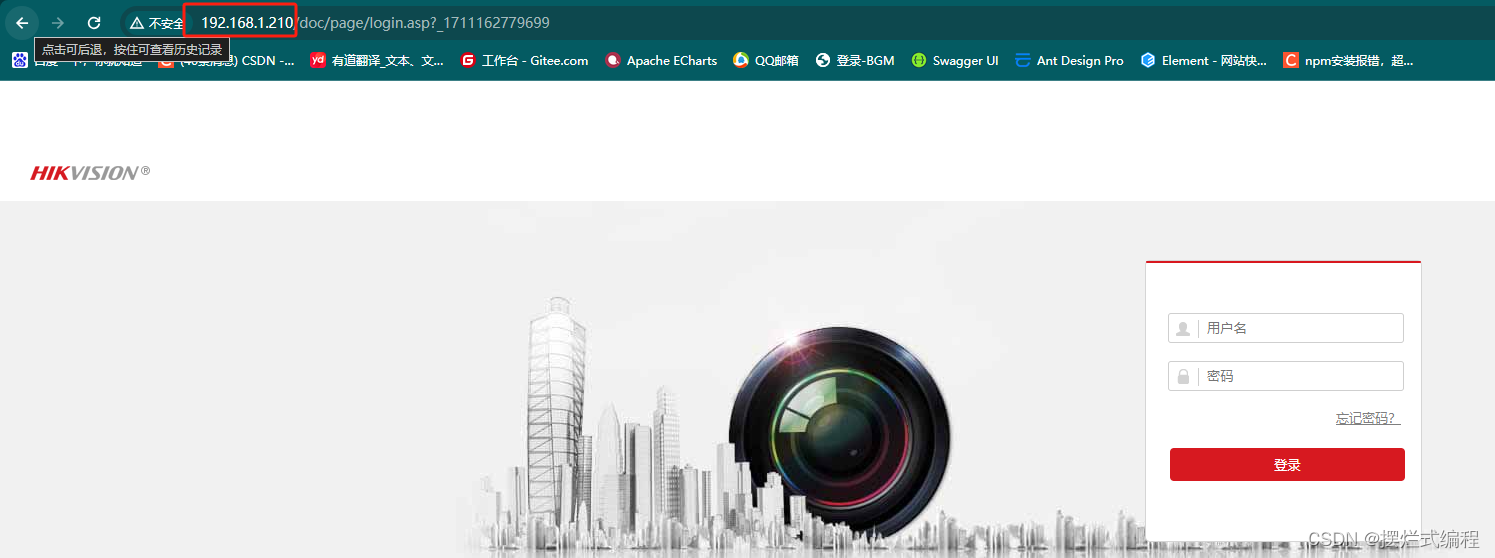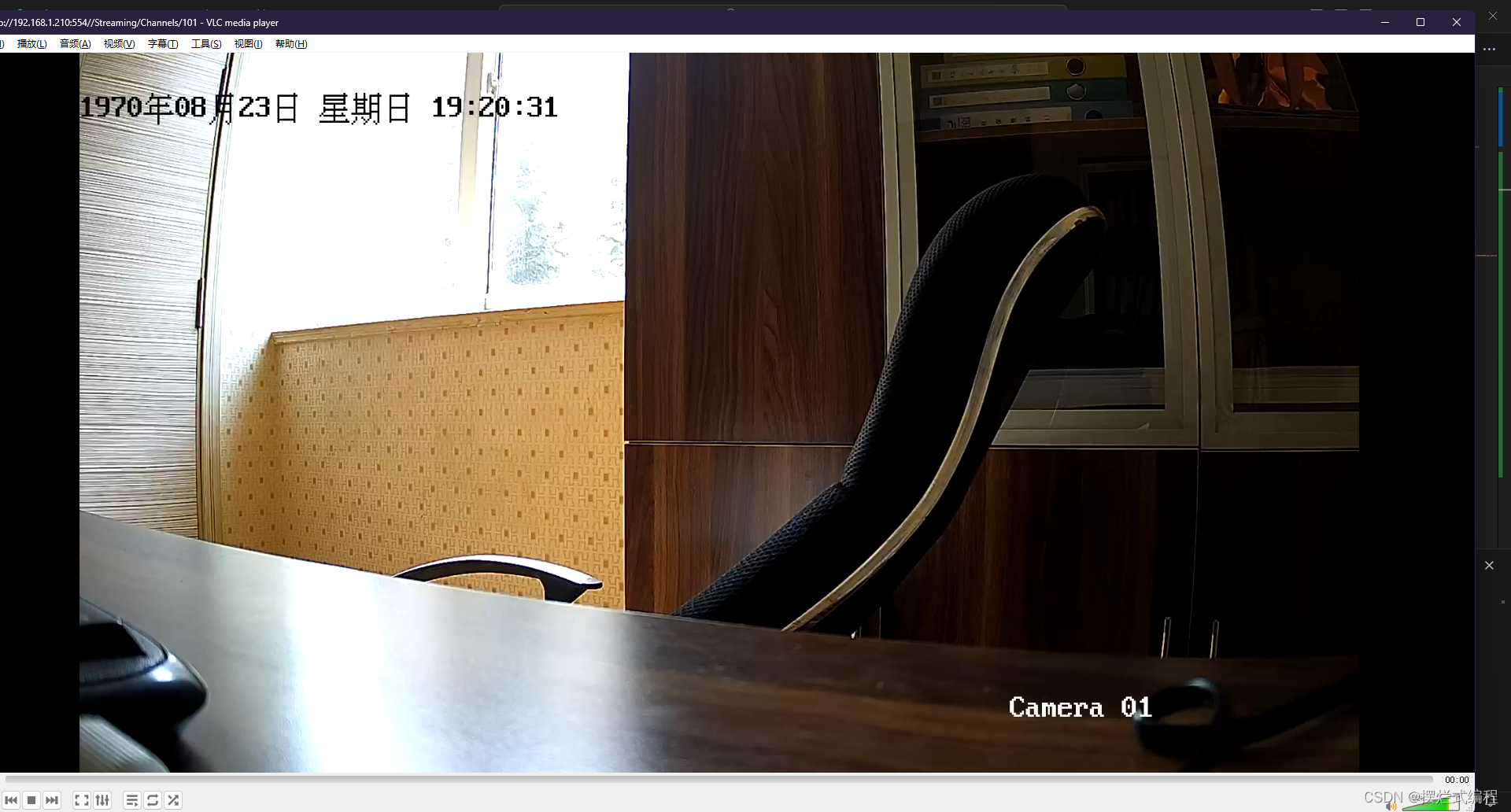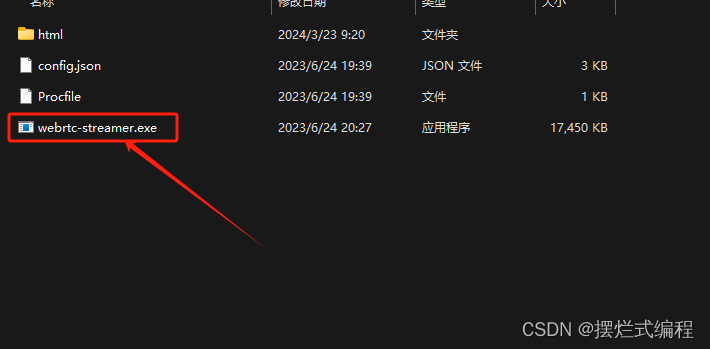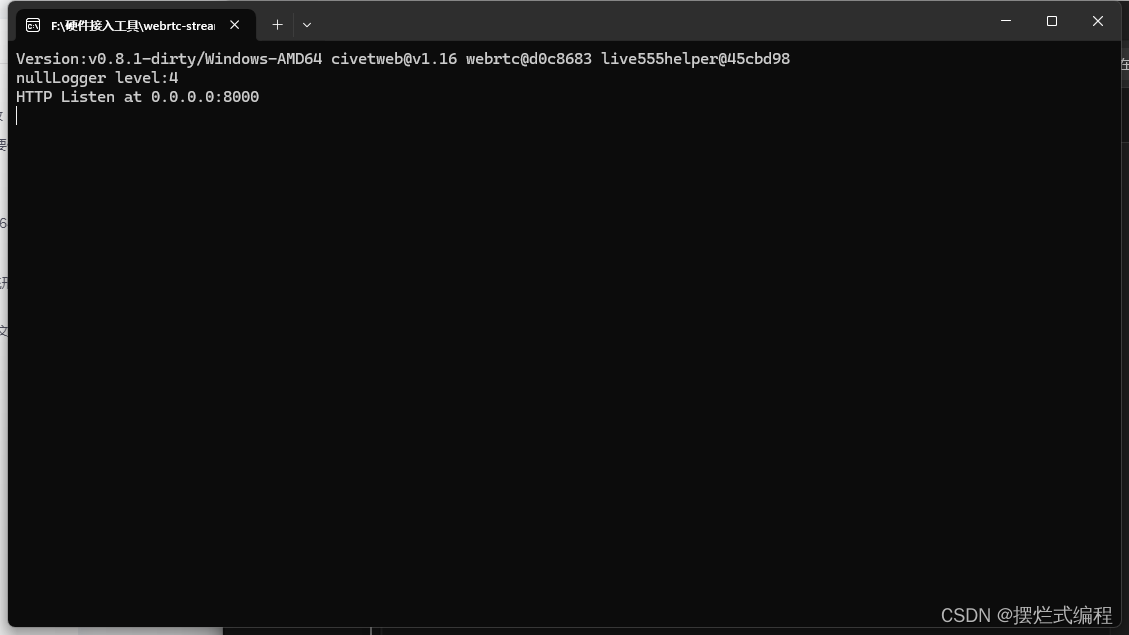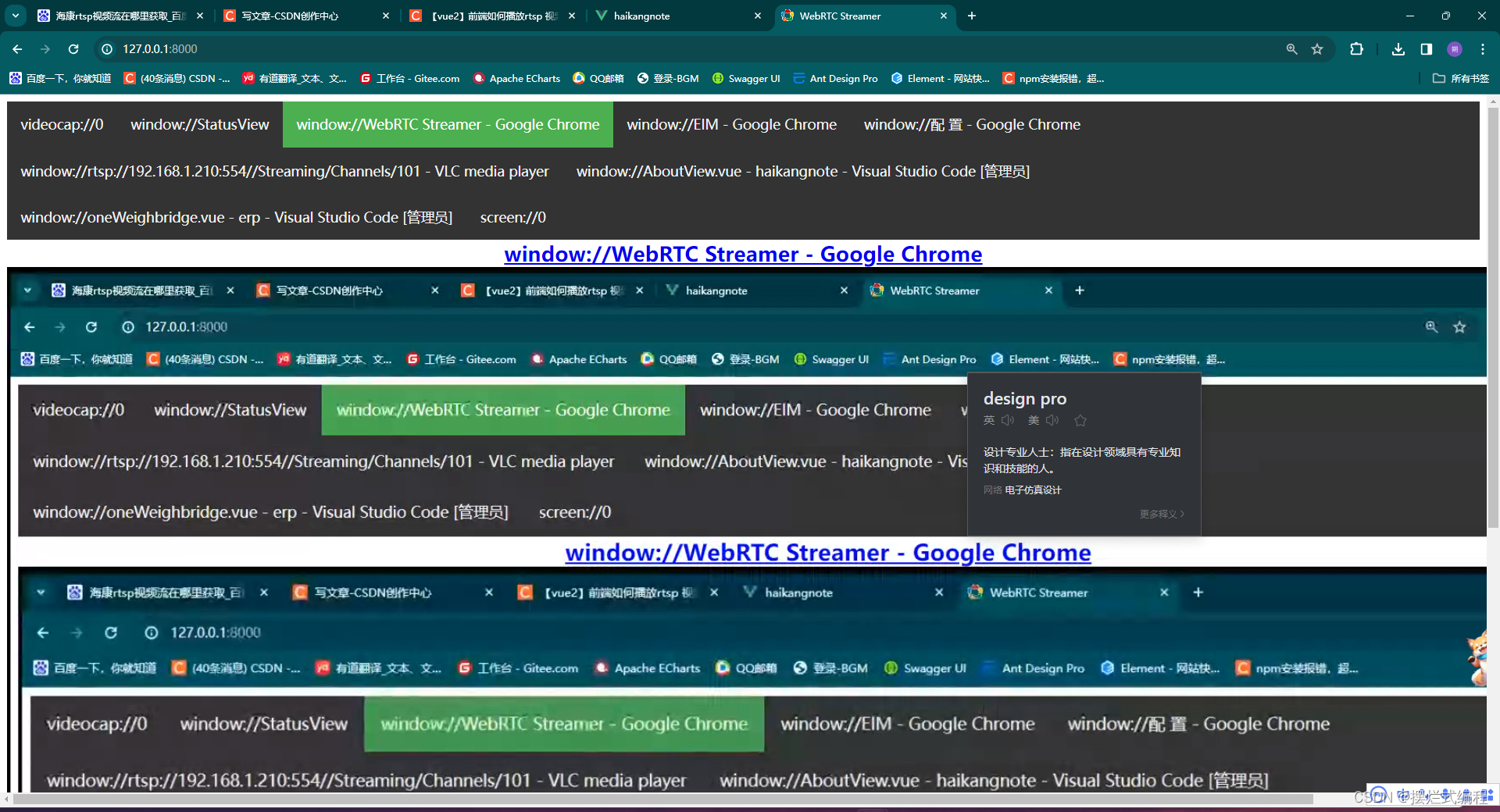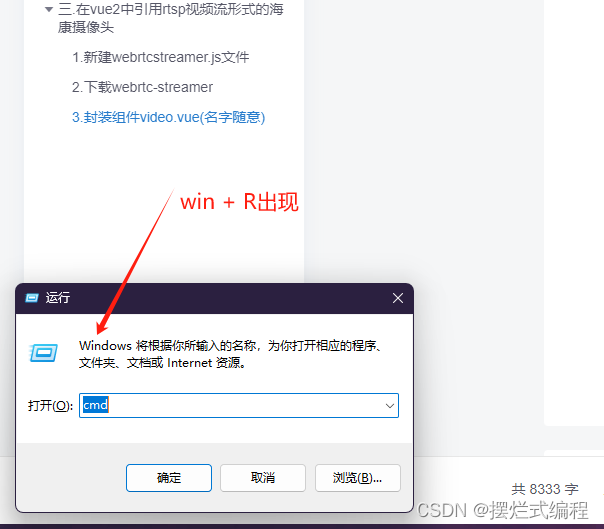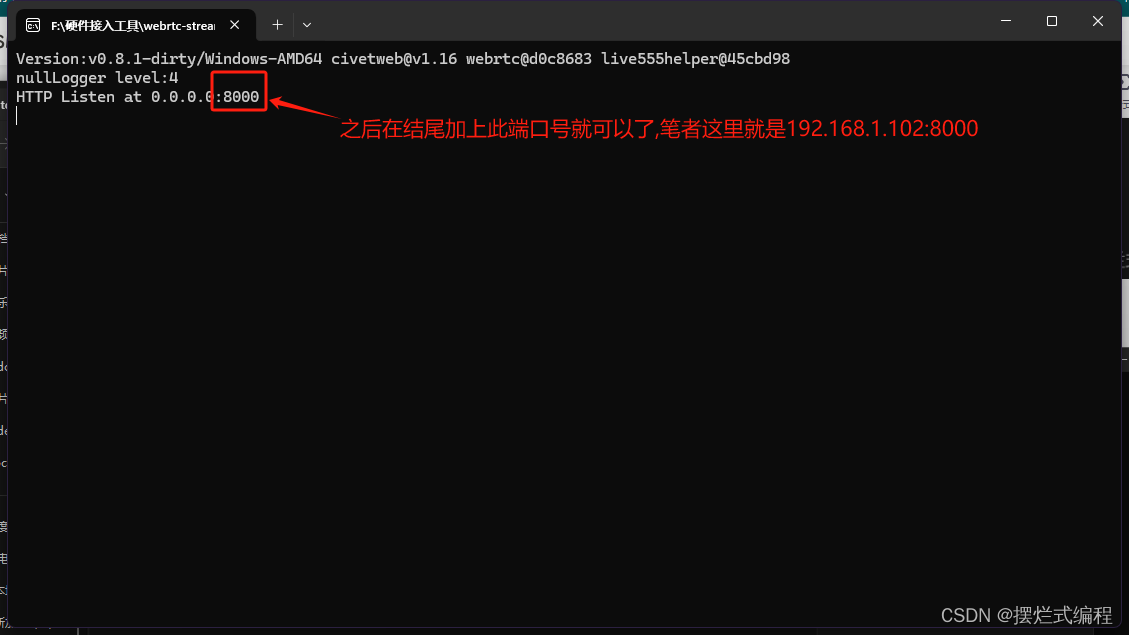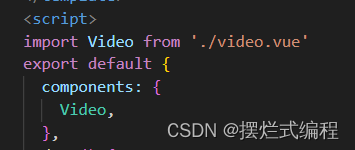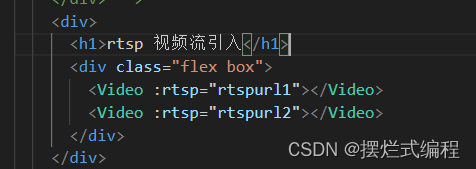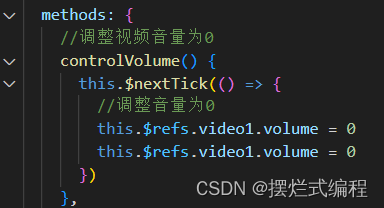vue2使用rtsp视频流接入海康威视摄像头(纯前端) |
您所在的位置:网站首页 › web摄像头实时监控 › vue2使用rtsp视频流接入海康威视摄像头(纯前端) |
vue2使用rtsp视频流接入海康威视摄像头(纯前端)
|
一.获取海康威视rtsp视频流
海康威视官方的RTSP最新取流格式如下: rtsp://用户名:密码@IP:554/Streaming/Channels/101 用户名和密码
所以笔者的rtsp流地址就是rtsp://用户名:密码@192.168.1.210:554/Streaming/Channels/101 二. 测试rtsp流是否可以播放 1.实现RTSP协议推流需要做的配置 1.1关闭萤石云的接入
在此下载 video mediaplay官网 即(VLC) 安装完成之后 打开VLC播放器 在VLC播放器中打开网络串流 输入rtsp地址 成功的话我们可以看到我们所显示的摄像头 如果RTSP流地址正确且取流成功,VLC的界面会显示监控画面。否则会报错,报错信息写在了日志里,在[工具]>[消息]里可以看到 三.在vue2中引用rtsp视频流形式的海康摄像头 1.新建webrtcstreamer.js文件在public文件夹下新建webrtcstreamer.js 代码贴在下方,复制粘贴即可 var WebRtcStreamer = (function() { /** * Interface with WebRTC-streamer API * @constructor * @param {string} videoElement - id of the video element tag * @param {string} srvurl - url of webrtc-streamer (default is current location) */ var WebRtcStreamer = function WebRtcStreamer (videoElement, srvurl) { if (typeof videoElement === "string") { this.videoElement = document.getElementById(videoElement); } else { this.videoElement = videoElement; } this.srvurl = srvurl || location.protocol+"//"+window.location.hostname+":"+window.location.port; this.pc = null; this.mediaConstraints = { offerToReceiveAudio: true, offerToReceiveVideo: true }; this.iceServers = null; this.earlyCandidates = []; } WebRtcStreamer.prototype._handleHttpErrors = function (response) { if (!response.ok) { throw Error(response.statusText); } return response; } /** * Connect a WebRTC Stream to videoElement * @param {string} videourl - id of WebRTC video stream * @param {string} audiourl - id of WebRTC audio stream * @param {string} options - options of WebRTC call * @param {string} stream - local stream to send */ WebRtcStreamer.prototype.connect = function(videourl, audiourl, options, localstream) { this.disconnect(); // getIceServers is not already received if (!this.iceServers) { console.log("Get IceServers"); fetch(this.srvurl + "/api/getIceServers") .then(this._handleHttpErrors) .then( (response) => (response.json()) ) .then( (response) => this.onReceiveGetIceServers(response, videourl, audiourl, options, localstream)) .catch( (error) => this.onError("getIceServers " + error )) } else { this.onReceiveGetIceServers(this.iceServers, videourl, audiourl, options, localstream); } } /** * Disconnect a WebRTC Stream and clear videoElement source */ WebRtcStreamer.prototype.disconnect = function() { if (this.videoElement?.srcObject) { this.videoElement.srcObject.getTracks().forEach(track => { track.stop() this.videoElement.srcObject.removeTrack(track); }); } if (this.pc) { fetch(this.srvurl + "/api/hangup?peerid=" + this.pc.peerid) .then(this._handleHttpErrors) .catch( (error) => this.onError("hangup " + error )) try { this.pc.close(); } catch (e) { console.log ("Failure close peer connection:" + e); } this.pc = null; } } /* * GetIceServers callback */ WebRtcStreamer.prototype.onReceiveGetIceServers = function(iceServers, videourl, audiourl, options, stream) { this.iceServers = iceServers; this.pcConfig = iceServers || {"iceServers": [] }; try { this.createPeerConnection(); var callurl = this.srvurl + "/api/call?peerid=" + this.pc.peerid + "&url=" + encodeURIComponent(videourl); if (audiourl) { callurl += "&audiourl="+encodeURIComponent(audiourl); } if (options) { callurl += "&options="+encodeURIComponent(options); } if (stream) { this.pc.addStream(stream); } // clear early candidates this.earlyCandidates.length = 0; // create Offer this.pc.createOffer(this.mediaConstraints).then((sessionDescription) => { console.log("Create offer:" + JSON.stringify(sessionDescription)); this.pc.setLocalDescription(sessionDescription) .then(() => { fetch(callurl, { method: "POST", body: JSON.stringify(sessionDescription) }) .then(this._handleHttpErrors) .then( (response) => (response.json()) ) .catch( (error) => this.onError("call " + error )) .then( (response) => this.onReceiveCall(response) ) .catch( (error) => this.onError("call " + error )) }, (error) => { console.log ("setLocalDescription error:" + JSON.stringify(error)); }); }, (error) => { alert("Create offer error:" + JSON.stringify(error)); }); } catch (e) { this.disconnect(); alert("connect error: " + e); } } WebRtcStreamer.prototype.getIceCandidate = function() { fetch(this.srvurl + "/api/getIceCandidate?peerid=" + this.pc.peerid) .then(this._handleHttpErrors) .then( (response) => (response.json()) ) .then( (response) => this.onReceiveCandidate(response)) .catch( (error) => this.onError("getIceCandidate " + error )) } /* * create RTCPeerConnection */ WebRtcStreamer.prototype.createPeerConnection = function() { console.log("createPeerConnection config: " + JSON.stringify(this.pcConfig)); this.pc = new RTCPeerConnection(this.pcConfig); var pc = this.pc; pc.peerid = Math.random(); pc.onicecandidate = (evt) => this.onIceCandidate(evt); pc.onaddstream = (evt) => this.onAddStream(evt); pc.oniceconnectionstatechange = (evt) => { console.log("oniceconnectionstatechange state: " + pc.iceConnectionState); if (this.videoElement) { if (pc.iceConnectionState === "connected") { this.videoElement.style.opacity = "1.0"; } else if (pc.iceConnectionState === "disconnected") { this.videoElement.style.opacity = "0.25"; } else if ( (pc.iceConnectionState === "failed") || (pc.iceConnectionState === "closed") ) { this.videoElement.style.opacity = "0.5"; } else if (pc.iceConnectionState === "new") { this.getIceCandidate(); } } } pc.ondatachannel = function(evt) { console.log("remote datachannel created:"+JSON.stringify(evt)); evt.channel.onopen = function () { console.log("remote datachannel open"); this.send("remote channel openned"); } evt.channel.onmessage = function (event) { console.log("remote datachannel recv:"+JSON.stringify(event.data)); } } pc.onicegatheringstatechange = function() { if (pc.iceGatheringState === "complete") { const recvs = pc.getReceivers(); recvs.forEach((recv) => { if (recv.track && recv.track.kind === "video") { console.log("codecs:" + JSON.stringify(recv.getParameters().codecs)) } }); } } try { var dataChannel = pc.createDataChannel("ClientDataChannel"); dataChannel.onopen = function() { console.log("local datachannel open"); this.send("local channel openned"); } dataChannel.onmessage = function(evt) { console.log("local datachannel recv:"+JSON.stringify(evt.data)); } } catch (e) { console.log("Cannor create datachannel error: " + e); } console.log("Created RTCPeerConnnection with config: " + JSON.stringify(this.pcConfig) ); return pc; } /* * RTCPeerConnection IceCandidate callback */ WebRtcStreamer.prototype.onIceCandidate = function (event) { if (event.candidate) { if (this.pc.currentRemoteDescription) { this.addIceCandidate(this.pc.peerid, event.candidate); } else { this.earlyCandidates.push(event.candidate); } } else { console.log("End of candidates."); } } WebRtcStreamer.prototype.addIceCandidate = function(peerid, candidate) { fetch(this.srvurl + "/api/addIceCandidate?peerid="+peerid, { method: "POST", body: JSON.stringify(candidate) }) .then(this._handleHttpErrors) .then( (response) => (response.json()) ) .then( (response) => {console.log("addIceCandidate ok:" + response)}) .catch( (error) => this.onError("addIceCandidate " + error )) } /* * RTCPeerConnection AddTrack callback */ WebRtcStreamer.prototype.onAddStream = function(event) { console.log("Remote track added:" + JSON.stringify(event)); this.videoElement.srcObject = event.stream; var promise = this.videoElement.play(); if (promise !== undefined) { promise.catch((error) => { console.warn("error:"+error); this.videoElement.setAttribute("controls", true); }); } } /* * AJAX /call callback */ WebRtcStreamer.prototype.onReceiveCall = function(dataJson) { console.log("offer: " + JSON.stringify(dataJson)); var descr = new RTCSessionDescription(dataJson); this.pc.setRemoteDescription(descr).then(() => { console.log ("setRemoteDescription ok"); while (this.earlyCandidates.length) { var candidate = this.earlyCandidates.shift(); this.addIceCandidate(this.pc.peerid, candidate); } this.getIceCandidate() } , (error) => { console.log ("setRemoteDescription error:" + JSON.stringify(error)); }); } /* * AJAX /getIceCandidate callback */ WebRtcStreamer.prototype.onReceiveCandidate = function(dataJson) { console.log("candidate: " + JSON.stringify(dataJson)); if (dataJson) { for (var i=0; i { console.log ("addIceCandidate OK"); } , (error) => { console.log ("addIceCandidate error:" + JSON.stringify(error)); } ); } this.pc.addIceCandidate(); } } /* * AJAX callback for Error */ WebRtcStreamer.prototype.onError = function(status) { console.log("onError:" + status); } return WebRtcStreamer; })(); if (typeof window !== 'undefined' && typeof window.document !== 'undefined') { window.WebRtcStreamer = WebRtcStreamer; } if (typeof module !== 'undefined' && typeof module.exports !== 'undefined') { module.exports = WebRtcStreamer; } 2.下载webrtc-streamer资源在最上面 也可以去github上面下载:webrtc-streamer 下载完解压,打开文件夹,启动webrtc-streamer.exe
打开完会出现cmd一样的黑框框如下
如果没有启动成功可以在浏览器中输入http://127.0.0.1:8000/查看本地端口8000是否被其他应用程序占用,如果没有被占用打开窗口应该如下图所示(是可以看见自己的页面的)
代码如下(但是有需要注意的地方,请看下方) import WebRtcStreamer from '../../public/hk/webrtcstreamer' export default { name: 'videoCom', props: { rtsp: { type: String, required: true, }, isOn: { type: Boolean, default: false, }, spareId: { type: Number, }, selectStatus: { type: Boolean, default: false, }, }, data() { return { socket: null, result: null, // 返回值 pic: null, webRtcServer: null, clickCount: 0, // 用来计数点击次数 } }, watch: { rtsp() { // do something console.log(this.rtsp) this.webRtcServer.disconnect() this.initVideo() }, }, destroyed() { this.webRtcServer.disconnect() }, beforeCreate() { window.onbeforeunload = () => { this.webRtcServer.disconnect() } }, created() {}, mounted() { this.initVideo() }, methods: { initVideo() { try { //连接后端的IP地址和端口 this.webRtcServer = new WebRtcStreamer( this.$refs.video, `http://192.168.1.102:8000` ) //向后端发送rtsp地址 this.webRtcServer.connect(this.rtsp) } catch (error) { console.log(error) } }, /* 处理双击 单机 */ dbClick() { this.clickCount++ if (this.clickCount === 2) { this.btnFull() // 双击全屏 this.clickCount = 0 } setTimeout(() => { if (this.clickCount === 1) { this.clickCount = 0 } }, 250) }, /* 视频全屏 */ btnFull() { const elVideo = this.$refs.video if (elVideo.webkitRequestFullScreen) { elVideo.webkitRequestFullScreen() } else if (elVideo.mozRequestFullScreen) { elVideo.mozRequestFullScreen() } else if (elVideo.requestFullscreen) { elVideo.requestFullscreen() } }, /* ison用来判断是否需要更换视频流 dbclick函数用来双击放大全屏方法 */ handleClickVideo() { if (this.isOn) { this.$emit('selectVideo', this.spareId) this.dbClick() } else { this.btnFull() } }, }, } .active-video-border { border: 2px salmon solid; } #video-contianer { position: relative; // width: 100%; // height: 100%; .video { // width: 100%; // height: 100%; // object-fit: cover; } .mask { position: absolute; top: 0; left: 0; width: 100%; height: 100%; cursor: pointer; } }这里要注意两个地方 第一个是 第二个是
不会查看本机端口的看这里(首先使用 Win + R打开运行 输入cmd)
首先我们在要使用video封装组件的地方引入并且注册video组件
之后在页面中使用video组件 并且定义了两个变量将rtsp流传给封装的video组件
效果图如下
之后声明一个方法
然后在created里面调用就静音了
到此为止海康摄像头引入vue的方法就完美完结了 如果同学们有什么好的意见或者有什么问题可以私信我 最后祝大家事业蒸蒸日上,心想事成!
|
【本文地址】
 IP就是登陆摄像头时候的IP(笔者这里IP是192.168.1.210)
IP就是登陆摄像头时候的IP(笔者这里IP是192.168.1.210)